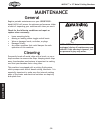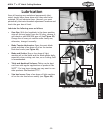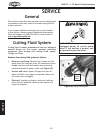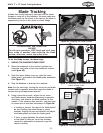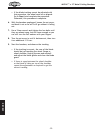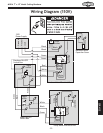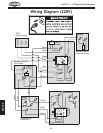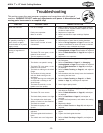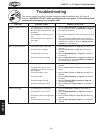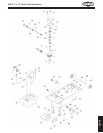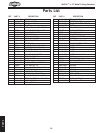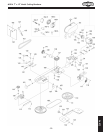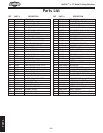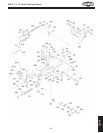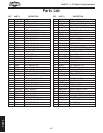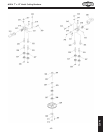
-36-
M1014 7" x 12" Metal Cutting Bandsaw
SERVICE
SYMPTOM POSSIBLE CAUSE CORRECTIVE ACTION
Teeth are ripping from the
blade.
1. The feed pressure is too heavy and
the blade speed is too slow; or
the blade TPI is too coarse for the
workpiece.
2. The workpiece is vibrating in the
vise.
3. The blade gullets are loading up
with chips.
1. Refer to Blade Selection on Page 24 and decrease
the feed pressure. Refer to Feed Rate on Page 27,
and adjust as required.
2. Re-clamp the workpiece in the vise, and use a jig if
required.
3. Use a coarser-tooth blade, make sure the brush is
working, and use cutting fluid to cool the blade and
flush the cut if required. Refer to Cutting Fluid on
Page 26 for fluid selection.
Motor is running too hot. 1. The blade tension is too high.
2. The drive belt is slipping.
3. The blade TPI is incorrect.
4. The saw is being overloaded.
1. Refer to Blade Tension on Page 20, and adjust as
required.
2. Refer to Belt Tension on Page 18, and adjust as
required.
3. Refer to Blade Selection on Page 24, and adjust
as required.
4. Refer to Blade Selection on Page 24 and decrease
the feed pressure, refer to Feed Rate on Page 27.
Use cutting fluid if required.
The cuts are crooked. 1. The feed pressure is too high.
2. The guide bearings are out of
adjustment, or too far away from
the workpiece.
3. The blade tension is low.
4. The blade is dull.
5. The blade speed is wrong.
6. The blade tracking is wrong.
1. Refer to Feed Rate on Page 27, and adjust as
required.
2. Refer to Blade Guides on Page 21 and replace or
adjust.
3. Refer to Blade Tension on Page 20, and adjust as
required.
4. Refer to Blade Selection on Page 24 and replace
the blade.
5. Refer to Changing Cutting Speed on Page 19,
and adjust as required.
6. Refer to Blade Tracking on Page 31, and adjust as
required.
The cuts are rough. 1. The feed pressure is too high.
2. The blade TPI is too coarse.
3. The blade is loose and slipping on
wheels.
4. The blade tracking is wrong.
1. Refer to Feed Rate on Page 27, and adjust as
required.
2. Refer to Blade Selection on Page 24, and adjust
as required.
3. Refer to Blade Tension on Page 20, and adjust as
required.
4. Refer to Blade Tracking on Page 31, and adjust as
required.
Troubleshooting
This section covers the most common symptoms and corrections with this type of
machine. WARNING! DO NOT make any adjustments until power is disconnected and
moving parts have come to a complete stop!



